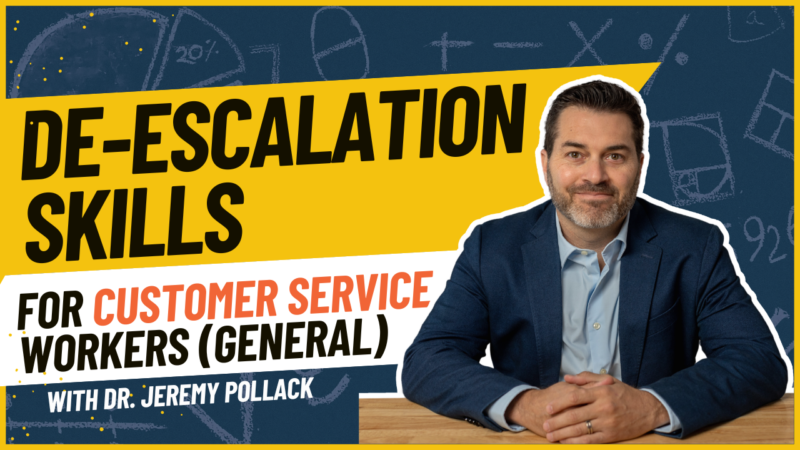Table of content
Conflict is a common occurrence in all work environments. De-escalation techniques are essential in preventing these situations from escalating further. At Defuse, we recognize the critical need to equip professionals with effective strategies to manage and calm tense situations.
When a person challenges you, it’s crucial to handle the situation with care and precision. This blog post explores the essential skills and approaches involved in de-escalation training and emphasizes its importance in maintaining workplace harmony and safety.
The Importance of De-Escalation in Conflict Resolution
Traditional conflict resolution methods typically address problems after they have intensified. However, de-escalation techniques serve as essential preventative tools. Below are some reasons why de-escalation is crucial in resolving conflicts effectively:
- Safety Enhancement: De-escalation helps maintain a safe environment by reducing the potential for violent outcomes or injuries.
- Early Intervention: By learning to take a few moments to assess the situation and respond appropriately, professionals can manage a person’s behavior before it escalates into a more severe conflict.
- Prevention of Critical Incidents: Effective de-escalation strategies can prevent situations from developing into critical incidents that could have lasting negative impacts on the workplace.
- Positive Work Environment: De-escalation fosters a more constructive and supportive atmosphere, which is crucial for productivity and employee satisfaction.
Identifying Triggers and Warning Signs of Escalation
Successful conflict management involves being aware of early warning signs and triggers that may lead to escalation. Recognizing these indicators, both verbal and nonverbal, is a fundamental aspect of effective de-escalation techniques.
Below are some key warning signs and triggers:
- Verbal Aggression: An increase in the volume of a person’s voice, or the use of personal attacks, can signal a rising person’s feelings of frustration or anger.
- Non-verbal Cues: Physical signs such as clenched fists, aggressive posture, or rapid, heavy breathing can indicate a person’s anxiety is escalating.
- Feeling Disrespected: A common trigger for escalation is the perception of being disrespected or undervalued. This often reflects a change in a person’s behavior.
- Pressure and Unmet Needs: Being under significant pressure or having critical needs unmet can quickly lead to heightened emotions, making the application of a de-escalation technique crucial for calming the situation.
How to De-Escalate Conflict Quickly and Effectively
De-escalating conflicts effectively demands flexible and thoughtful approaches. While no single method suits every situation, several foundational de-escalation techniques can be universally applied.
Here’s how you can de-escalate situations rapidly and effectively:
- Prioritize Communication: Maintain a composed and respectful tone to foster a calm environment. It’s vital to actively listen and acknowledge the other person’s feelings without passing judgment.
- Personal Space: While maintaining necessary eye contact, it’s crucial to respect personal space to prevent the escalation from intensifying.
- Body Language: To further de-escalate situations, ensure your gestures are open and non-threatening. Avoid crossing your arms or making abrupt movements; instead, keep your body language neutral.
- Offer Options and Focus on the Present: Present practical solutions that meet the immediate needs of all parties involved. Concentrate on resolving the current issue rather than revisiting past conflicts, as this helps in steering the discussion toward a constructive resolution.

De-Escalation Examples in the General Workplace
1. A coworker feels they’ve been passed over for a promotion. They approach you in a heated manner.
Imagine a scenario where a coworker, visibly upset and frustrated, confronts you about not receiving a promotion they felt they deserved. They may speak in a raised voice or display aggressive body language, like clenched fists or a stern face. The key to de-escalating this situation involves several thoughtful steps.
First, acknowledge their frustration with genuine understanding: “I see you’re really disappointed about the promotion—let’s talk about it.” This initial acknowledgment can diffuse immediate tension and show you are open to listening.
Next, actively listen to their concerns without interrupting, which shows respect and consideration for their perspective. You might say, “I hear that you feel overlooked despite your hard work, and that must be tough.”
Empathize with their feelings to further connect and reduce their agitation. A response like, “It sounds like you’re feeling really undervalued, and that’s a hard place to be,” can help soften their emotional state.
Finally, offer constructive options: “How about we set up a time to discuss your career goals? I think it could also be beneficial to meet with your manager and explore future opportunities that align with your aspirations.”
2. A client expresses dissatisfaction with a project’s progress. Conversation becomes increasingly heated.
Picture a meeting room where tensions rise as a client voices their dissatisfaction about the slow progress of a project. Their tone is sharp, and their gestures become more animated, signaling growing frustration. As the atmosphere heats up, it’s crucial to begin de-escalating the situation effectively.
Start by offering reassurance to show understanding and commitment: “I completely understand your concerns about the timeline, and it’s our priority to address them.”
Next, engage in active listening, summarizing their key points to confirm that their message is being accurately received: “You’re worried about meeting the project deadline given the current pace, correct?”
It’s also helpful to validate their feelings, which can make them feel heard and respected: “It’s completely natural to feel frustrated when things aren’t progressing as planned. I’d feel the same in your position.”
Now, consciously maintain a respectful personal space and possibly engage in subtle deep breathing to keep your own responses calm and measured. Then, offer practical solutions or propose a detailed plan for the next steps: “Let’s outline the immediate actions we will take to accelerate progress and set a quick follow-up meeting to review these adjustments. Does that sound good to you?”
De-Escalation Examples in Healthcare
3. Family members of a patient are distraught after receiving bad news.
In the quiet hallway of a hospital, a doctor delivers difficult news to a patient’s family. Their initial shock quickly turns to audible distress, with tears and raised voices filling the tense air. Their facial expressions are anguished, and you can almost feel their blood pressure rising with every passing second. This delicate situation must be carefully de-escalated.
As a healthcare provider, it’s crucial to maintain a calm and compassionate presence. Allow the family ample time to express their emotions, refraining from interrupting their outpouring of grief. This respectful silence is often more comforting than any words could be.
When appropriate, offer words of comfort and validate their feelings: “It’s completely understandable to feel overwhelmed by such news. It’s okay to feel this way.” This approach of showing empathy can help mitigate their immediate pain.
Highlight the key points of support and care available to them, “We’re here to support you through this. Let’s talk about the next steps and the resources we can offer to help you during this time.”
Discover our de-escalation training offerings for healthcare providers.

De-Escalation Examples in Education
4. A student is acting out and disrupting the class.
In the midst of a lively classroom, one student begins to act out, disrupting the lesson with loud interruptions and erratic behavior. This situation not only challenges classroom management but also risks escalating into a power struggle between the student and the teacher.
To effectively de-escalate, the teacher should first ensure that the student’s personal space is maintained to avoid additional stress. Privately addressing the student can help prevent embarrassment and defuse the situation without audience pressure.
In a calm and secluded area, express genuine concern for the student’s well-being: “I’ve noticed you seem upset today, and I’m here to help. Can you tell me what’s bothering you?” This approach of actively listening fosters a safe environment for the student to open up about their feelings.
Offering a space for the student to cool down is crucial: “If you feel overwhelmed, you can take a short break outside. Come back when you feel ready, and we can try to sort this out together.” This method helps the student regain composure and reflects an effort to build rapport and trust, encouraging them to rejoin the class on positive terms.
Discover our de-escalation training offerings for educators.
De-Escalation Examples in Security/Law Enforcement
5. A driver becomes agitated during a traffic stop.
During a routine traffic stop, a law enforcement officer approaches a vehicle. The driver, already flustered from being pulled over, becomes visibly more agitated as the officer nears. This scenario is common, where heightened emotions can escalate quickly.
The officer, trained in de-escalation, maintains a calm and professional demeanor. Keeping a safe distance, they employ nonverbal communication that is non-threatening—open hands, relaxed posture, and occasionally taking a deep breath to maintain composure.
Using concise and respectful language, the officer avoids accusatory tones: “I stopped you because your taillight is out. It’s important for your safety. Can I see your driver’s license, please?” This clear communication helps mitigate misunderstandings that might cause the driver trouble identifying the reason behind the stop.
Discover our de-escalation training offerings for security and police officers.
De-Escalation Examples in Hospitality
6. A guest is unhappy with their room or service.
In a bustling hotel lobby, a guest approaches the reception desk, clearly upset about the condition of their room or the level of service received. Given that they’ve invested money and expectations into their stay, their frustration is palpable, contributing to a stressful situation.
The hotel staff member quickly acknowledges the guest’s frustration and offers a sincere apology for any inconvenience: “I’m truly sorry to hear about your experience. Let’s make it right.” This initial recognition is crucial in demonstrating the hotel’s commitment to guest satisfaction.
Employing active listening skills, the staff member carefully listens to the person’s concerns, showing genuine interest and understanding. “I understand how disappointing this must be for you, and I appreciate you bringing it to our attention.”
To resolve the issue and turn the guest’s experience around, the staff member offers practical solutions: “We can arrange a room upgrade immediately or provide a complimentary service to improve your stay. Which option would you prefer?”
Discover our de-escalation training offerings for hotel staff.

De-Escalation Examples in Social Workers
7. A client is experiencing a mental health crisis.
In the quiet, confined space of a social worker’s office, a client begins to show signs of a mental health crisis—their emotions raw and intense. Recognizing the gravity of the situation, the social worker employs active listening, giving the client undivided attention and acknowledging their feelings without judgment. This approach helps the client feel understood and less isolated.
The social worker sets realistic expectations for the session, gently explaining what can be addressed immediately and what might require further intervention. “It’s important that we focus on what I can help you with right now, and we’ll also plan for the right support going forward.”
Throughout the interaction, the social worker remains calm and uses soothing tones to avoid unnecessary altercations. By maintaining a non-confrontational stance and speaking in reassuring phrases, the social worker helps to stabilize the client’s emotional state, guiding them toward a safer and more controlled frame of mind.
Discover our de-escalation training offerings for social workers.
De-Escalation Examples in Real Estate
8. A tense open house situation.
During an open house, a potential buyer becomes visibly upset over what they perceive as misleading information about the property. The atmosphere turns into a tense situation as the buyer’s tone grows confrontational when questioning the integrity of the property details.
To de-escalate, the real estate agent needs to remain calm and address the buyer’s concerns directly. Maintaining steady eye contact and a composed demeanor reassures the buyer that their concerns are being taken seriously.
The agent needs to listen attentively but also strategically ignore challenging questions that might provoke further conflict, focusing instead on clarifying misunderstandings. “I understand your concerns, and I want to ensure you have all the correct details. Let’s go through the information again together.”
Discover our de-escalation training offerings for real estate agents.
De-Escalation Examples in Customer Service
9. A heated call center interaction.
Customer service can be challenging, especially in a call center environment where agents often face irate callers. One such scenario unfolds when a customer calls to complain about a service disruption, their frustration mounting as the conversation progresses. As the situation escalates, the call center agent must employ effective de-escalation tactics.
First and foremost, the agent practices active listening, ensuring the customer feels heard and understood: “I hear that this disruption has really inconvenienced you, and I’m here to help.” Throughout the call, the agent must remain calm and composed, using a steady and reassuring tone to communicate empathy and a willingness to resolve the issue.
Ignore challenging questions that might sidetrack the conversation or increase tension, focusing instead on problem-solving with the client. “Let’s focus on finding a solution together. Can you tell me more about the issue so I can better assist you?”
This approach not only soothes the customer but also facilitates a productive dialogue. Effective call center de-escalation techniques help transform potentially volatile interactions into opportunities for problem resolution and customer satisfaction.
Discover our de-escalation training offerings for customer service representatives.
Enhance Your De-Escalation Skills with Defuse
Explore Defuse’s comprehensive de-escalation programs and certifications. Equip yourself with the skills to manage and resolve conflicts effectively, ensuring safety and harmony in your workplace. Join us and make a positive impact today.




